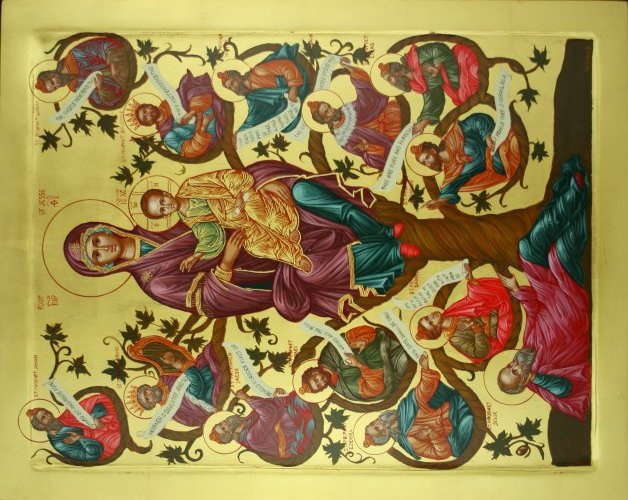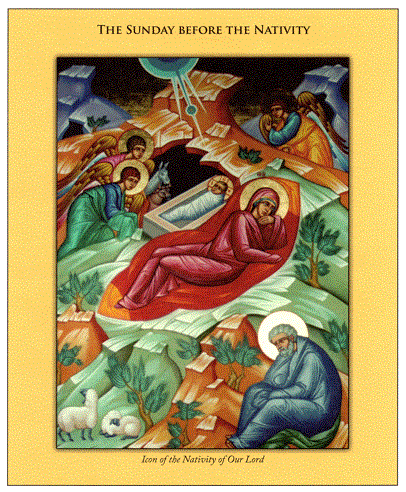We celebrate today the memory of the Ancestors of Christ.
Sing with fervor a hymn of praise to Christ the Savior who magnified them among all nations. He is the Lord Who does wondrous deeds because He is powerful and mighty, and Who shows us His strength through these Ancestors.

Behold, our forty-day preparation for the feast of the Nativity has almost come to an end. As we begin our final days of preparation for this glorious feast, the Church has us remember the Ancestors of Christ. Matthew’s Gospel begins with a genealogy of Jesus, saying: a family record of Jesus Christ, son of David, son of Abraham.
The Eastern Church’s icon representing Jesus’ family lineage traditionally begins with Jesse and not with Abraham. Jesse was the father of King David who made Jerusalem his capitol and reconquered Canaan in the “Promised Land.” He reigned for 40 years and then named Solomon his successor. He was the king who, after King Saul, ruled the consolidated the Kingdom of Judah and Israel. He is said to be the composer of the Psalms and the one who killed Goliath.
The Tree of Jesse is a depiction in art of the ancestors of Christ, shown in a tree which rises from Jesse of Bethlehem and is the original use of the family tree to schematically present a genealogy. It originates in a passage in the Book of Isaiah which describes metaphorically the descent of the Messiah and is accepted by Christians as referring to Jesus. The various figures depicted in the lineage of Jesus are drawn from those names listed in the Gospels of Matthew and Luke. The genealogies of Jesus found in both Matthew and Luke are not parallel, nor are there parallels elsewhere in their Gospels. It is difficult to reconcile some of the details in the accounts of Matthew and Luke. The absence of the infancy narratives in Mark suggests very strongly that these narratives did not exist in the earliest forms of Christian traditions about Jesus and that the various traditions about the infancy were only formed later. Matthew’s version of the traditions is greatly affected by the use of Old Testament texts.
The purpose of the genealogy is to show that Jesus is the Messiah, the term in the history of salvation that was begun with the promises to Abraham.
The genealogy is deliberately compiled in three sets of fourteen names – fourteen being a multiple of seven. It is divided at the two critical points of Israelite history, the foundation of the monarchy of David and the collapse of the monarchy of Judah in the Babylonian conquest of 587 BCE. The artificiality of the numbers is maintained by the omission of some names. Matthew follows the line of the kings of Judah.
Luke’s Gospel follows a cognate line.
Matthew’s genealogy up to Zerubbabel could be formed by copying from a text in the Old Testament. For the rest of the genealogy, there is no documentary source with which we can compare it.
Four women appear in the genealogy: Tamar, Rahab, Ruth and Bethsheba. No principle governs their inclusion. The only common element is that they were foreigners.
The number fourteen in the third group can be maintained only by including Mary or by counting Jesus and Christ as two. It is possible that a name was omitted in the early transmission of the text. One could explain the inclusion of Mary because of the virgin birth, clearly declared in the following passage. If Jesus and Christ are counted as two, the duality could be understood as referring to his nativity in the flesh and to his Second Coming. In Matthew such an eschatological allusion is common.
The reconciliation of the divergent genealogies of Matthew and Luke already was a celebrated problem in patristic times. Reconciliation assumes that both genealogies are compiled from reliable records. It is know that genealogies were kept in the post-exilic Jewish community, but this does not prove that genealogies were available to Matthew and Luke. It is much simpler to suppose that each genealogy was compiled artificially where the biblical record failed or where Luke, for reasons of his own, chose not to follow the line of the kings of Judah.
As some scholars look at the two different genealogies, they deduce that Matthew’s genealogy is actually that of Joseph and Luke’s is that of Mary. It seems that Bethlehem was actually Joseph’s hometown.
Why did both Matthew and Luke construct their genealogies? I think for several reasons: (1) to prove that Jesus was of the House of David and the awaited Messiah; (2) to prove that He was a real human being with a family lineage; and (3) to locate Him in time. Further, it is important to note, only members of royal families ever had a genealogy developed. Having His own genealogy gives Jesus the true stature of royalty. Also, when you remember the prophecy of Isaiah which stated that the Messiah would find His root in the House of Jesse, King David’s father, it all begins to make sense. We have to remember that when the Gospels were written, the Christians didn’t have a clear idea of the virgin birth and the divinity of Jesus. The Messiah was never prophesied as God incarnate in the Old Testament. He was the Son of Man, a great prophet and king who would free Israel from captivity and rule over the People of God. We must remember that God’s promised Messiah was not a king.
That’s what the people wanted!

